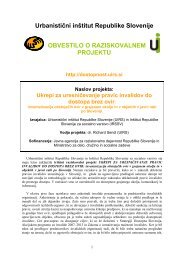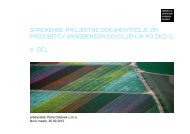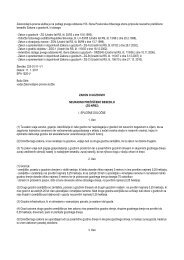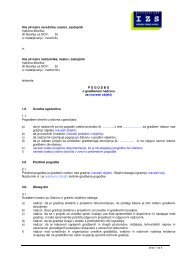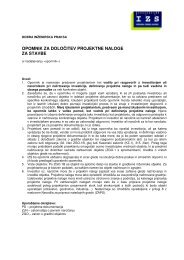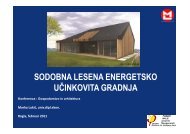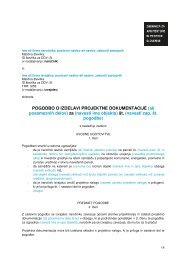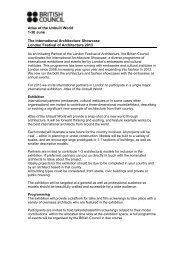Saša PIANO, univ. dipl. inž. kraj. arh.predsednica matične sekci<strong>je</strong> krajinskih arhitektovPresident of the central section of landscape architectsUrejan<strong>je</strong> prostora <strong>je</strong> že od nekdaj razpeto med politiko, kapitalomin stroko, saj <strong>je</strong> prostor izvrsten medij, preko katerega se vsi ti izražajoin predstavljajo. Razmer<strong>je</strong> med njimi <strong>je</strong> lahko uravnoteženo, običajnopa <strong>je</strong> na strani močnejšega. Stroka <strong>je</strong> pogosto najšibkejši člen, saj <strong>je</strong> skozizakonodajo odvisna od politike, skozi kapital pa od investitor<strong>je</strong>v.Zato <strong>je</strong> zanjo zelo pomembno, da se javnosti čim večkrat predstavi.Nagra<strong>je</strong>van<strong>je</strong> n<strong>je</strong>nih kakovostnih stvaritev <strong>je</strong> dober način in tudipriložnost, da se na ogled postavi vsak, ki to želi. Priprava gradiva zarazstavo <strong>je</strong> samokritična analiza dela vsakega posameznika, celotnarazstava pa <strong>je</strong> pregled dosežkov v nekem časovnem obdobju, ki <strong>je</strong> pomembentudi zaradi izobraževanja, vzgo<strong>je</strong> in širitve obzorja družbe. Zato <strong>je</strong>pomembno, da stroka tudi sama opozarja nase, na svo<strong>je</strong> dobre rešitve in stem seznanja politiko in kapital, da obstaja, da zna in da ve, kaj naj dela.Samo prostorsko izobražen naročnik bo pripravl<strong>je</strong>n investirati v kakovostneureditve in samo prostorsko izobražen politik bo znal ustvarjatidobro prostorsko zakonodajo. V tej luči postaja nagrada zlati svinčnik izleta v leto pomembnejša.Nekoč <strong>je</strong> bilo oblikovan<strong>je</strong> prostora ena izmed umetnosti, naj <strong>je</strong> šlo zastavbo ali vrt. Stvaritve, ki jih danes obravnavamo kot velike (umetniške)dosežke, so bile praviloma stvaritve same zase, saj so se le redke umestilev prostor neopazno (tudi neopaznost <strong>je</strong> kvaliteta). Današnji pogled naprostor <strong>je</strong> z vidika zahtevnih ekoloških vprašanj drugačen. Zato <strong>je</strong> prepletveč strok, ki pri tem nastopajo, ter povezav med prostorskim načrtovan<strong>je</strong>min pro<strong>je</strong>ktiran<strong>je</strong>m konkretnih rešitev zelo pomemben. Nekatera nagra<strong>je</strong>nadela te razstave to potrju<strong>je</strong>jo: gre za izvedbe, pri katerih ne moremoodčitati samo dobre arhitekture ali samo dobre krajinske arhitekture,ampak jih dojamemo kot kakovostne celote, ki temeljijo tudi na kakovostnemprostorskem načrtovanju. Ne glede na pomen vsakega posameznikaso najboljše rešitve gotovo plod dela več strokovnjakov različnih znanjin izkušenj, pri čemer se vsa znanja kakovostno združijo, prepletejoin ustvarijo dober rezultat. Vsak, ki se ukvarja s prostorom, dela tudi zjavnostjo in za njo, zato <strong>je</strong> n<strong>je</strong>gova odgovornost zelo velika.Trenutna največja težava urejanja prostora v Sloveniji <strong>je</strong>, ob pogostemnezaupanju stroki, nemoč zakonoda<strong>je</strong> in velika moč kapitala, kipredvsem v lokalnih skupnostih vedno znova zmagu<strong>je</strong>: z izsil<strong>je</strong>van<strong>je</strong>mlokacij, neustreznimi rešitvami za posamezne lokaci<strong>je</strong> in marsikdaj slabimizunanjimi ureditvami. Pogosto namreč ob<strong>je</strong>kti ne izkoristijo kvalitetprostora, v katerega se umeščajo, večkrat jih celo razvrednotijo. Odprte,posebej pa javne površine so pri tem najbolj zapostavl<strong>je</strong>ne. Dobičkonosnanaravnanost <strong>je</strong> tudi vzrok pomanjkanja naročil ureditev javnega prostora,kot so parki, trgi in podobno, ki so za lokalne skupnosti finančnozahtevne ureditve in čeprav poveču<strong>je</strong>jo kakovost bivanja, ne prinašajoneposrednega dobička. Zato bi morala biti prostorska politika naravnanatako, da bi iz ureditev kapitala iztržila sredstva za urejan<strong>je</strong>, naročan<strong>je</strong>,izvajan<strong>je</strong> in vzdrževan<strong>je</strong> drugih, nekomercialnih javnih površin, hkrati paSpatial design has always been torn between politics, capital and profession,because space is an ideal medium through which all of the above representand express themselves. The relationship among them may be balanced, butusually the balance will be tilted in favour of the stronger party. The professionis often the weakest link, as it depends, through legislation, on politics; andthrough capital on investors. It is therefore of high importance that it – theprofession – should be introduced to the public as often as possible. Awardingquality creations is a good way to do that. It is also an opportunity for anyonewho so wishes to be “put on exhibition”. Preparing the exhibition material is aself-critical analysis of each individual’s work, while the entire exhibition offersa survey of quality work during a certain period of time, important for the sakeof education and for broadening the society’s horizons. This is why professionalsshould draw attention to the discipline and the viable solutions they produce, inthe process informing the politicians and the capital of their existence and theirknowledge of how and what to do. Only clients with a spatial background will bewilling to invest in quality designs and only politicians with spatial backgroundwill know how to create viable spatial legislation. Seen in this light, the GoldenPencil Award is becoming increasingly important every year.Space design used to constitute one of the arts, whether it was a buildingor a garden. The creations seen today as great (artistic) achievements were, as arule, creations in their own right, as only few of them inconspicuously blendedinto space (which is not to say that being inconspicuous is not a quality). Inlight of ecological issues it is obvious that today’s view on space is different.Cooperation between different disciplines involved in dealing with this issue, aswell as liaisons between spatial planning and development of specific solutionsis therefore essential. Some of the awarded works in this exhibition confirm this:realizations that manifest more than just excellent architecture or landscapearchitecture, but are seen as a quality whole based on correspondingly effectivequality spatial planning. Regardless of the importance of each individual, thebest solutions are definitely the result of work of several experts from differentfields working together, with consideration for each other’s knowledge andexperience. Having put all this soundly together they can see a good result cometo life. Everybody dealing with space works with and for the public and theirresponsibility is accordingly considerable.In addition to officials’ ignorance of the spatial experts’ input, the mostpressing issues in spatial design in Slovenia at the moment are the impotenceof legislation and the enormous power of capital that continues to dominate,especially on the local community level – by enforcing both locations and unsuitablesolutions for certain locations and often also with poor open space design.As is often the case, facilities fail to incorporate the full potential of a given spaceand consistently devaluate it. Open spaces, especially public spaces, are the mostdisregarded in this respect. A tendency to profit is also the reason behind the lackof public space design tenders for facilities such as parks, markets and similar,which are financially burdensome for local communities and do not make fordirect profits, even though they contribute to a higher quality of life. Spatial 10
KRAJINSKA ARHITEKTURA V SLOVENSKI ARHITEKTURI IN PROSTORU 2007–2009LANDSCAPE ARCHITECTURE IN SLOVENIAN ARCHITECTURE AND SPATIAL PLANNING 2007-200911bi postavljala pogo<strong>je</strong> kakovostnega urejanja. Vlagan<strong>je</strong> le javnih sredstev vjavne odprte površine ni zadostno. Stan<strong>je</strong> se postopno izboljšu<strong>je</strong>, a hkratitudi niha v ciklih volilnih obdobij; poveču<strong>je</strong> se število nateča<strong>je</strong>v za urejan<strong>je</strong>odprtih prostorov (izvajan<strong>je</strong> natečajnih del pa žal prepogosto ostane vpredalu) in mednarodnih razpisov.Sistem odprtih površin v naselju enakovredno obliku<strong>je</strong>jo, polegjavnih površin, vse poljavne in zasebne površine. Te ureditve so včasihpredvsem funkcionalne (parkirišča ipd.), lahko so samo reprezentančne(površine pred upravnimi stavbami ipd.) ali površine, namen<strong>je</strong>neživl<strong>je</strong>nju vsakega izmed nas (zasebni vrtovi, trgi, parki, otroška igriščaidr.). Izhodiščna zamisel urejanja odprtih prostorov <strong>je</strong>, da so namen<strong>je</strong>nikakovostnemu bivanju in delu ljudi ter da presegajo le funkcionalnost(najbolj preprosto parkirišče <strong>je</strong> lahko ure<strong>je</strong>no premišl<strong>je</strong>no in presega lesvojo osnovno funkcijo). Ure<strong>je</strong>nost vsake hiše in vrta <strong>je</strong> za nasel<strong>je</strong> enakopomembna kot ure<strong>je</strong>nost javnih ob<strong>je</strong>ktov, upravnih stavb gospodarskihorganizacij in parkov, trgov, otroških igrišč. Zato so odprte površine vednodel javnega prostora, čeprav so povsem zasebne. Urejan<strong>je</strong> oprtih površinzunaj naselij pa <strong>je</strong> mnogo kompleksnejše, <strong>je</strong> del oblikovanja kulturnekrajine in <strong>je</strong> tesno povezano s prostorskim načrtovan<strong>je</strong>m in načinomravnanja oziroma gospodar<strong>je</strong>nja s prostorom.Posebnost stvaritev krajinske arhitekture <strong>je</strong>, da se njihova pravapodoba pokaže v daljšem časovnem obdobju, ko rastlin<strong>je</strong> zraste in ureditveprevzamejo podobo, ki so si jo zamislili njihovi snovalci. Hkratitudi niso povsem predvidljive, posebno tiste, ki so oblikovane pretežno zzelenim materialom. Krajinske ureditve počasi dozorijo in če se ohranijov svoji zasnovi, šele čez čas pokažejo svojo celovito kvaliteto.Urejan<strong>je</strong> odprtih prostorov se med seboj razliku<strong>je</strong>: so ureditve,katerih kvaliteta <strong>je</strong> presežek v smeri dobrega oblikovanja, in so ureditve,katerih največja kvaliteta <strong>je</strong> njihova sonaravnost. Te so velikokratzahtevnejše, obo<strong>je</strong> pa so med seboj težko primerljive.Urejan<strong>je</strong> odprtih prostorov v urbanem in ruralnem prostoru <strong>je</strong>domena krajinske arhitekture, ki vse bolj stopa iz anonimnosti, s tempa hkrati vse bolj poveču<strong>je</strong> tudi svojo odgovornost. Vse več krajinskiharhitektov prijavlja svo<strong>je</strong> ureditve na razpis zbornice, sodelu<strong>je</strong>jo pa kotpro<strong>je</strong>ktanti in kot prostorski načrtovalci. Vendar prostora ne gradijo samorešitve, o katerih se govori, ki so nagra<strong>je</strong>ne ipd., prostor gradijo številne,največkrat anonimne ureditve, ki jih sreču<strong>je</strong>mo na vsakem koraku. Pravkakovost ali nekakovost teh ureditev gradi celoto. Zato bi želeli nagradititudi tiste ureditve, ki so bile zasnovane tako, da so se povsem u<strong>je</strong>le v prostoruin času in zan<strong>je</strong> niti ne pomislimo, da so bile skrbno načrtovane. Najbo to tudi poziv tistim kolegom, ki vsak dan delajo dobre stvari in ki sejim ne zdijo pomembne. In naj bo pohvala vsem tistim, ki so pripravl<strong>je</strong>nipokazati, kaj in kako delajo, in s tem prevzeti odgovornost za pomembendel promoci<strong>je</strong> svo<strong>je</strong> stroke.policy should therefore be oriented so as to exert funds from “capital regimes”in order to design, order, implement and maintain other non-commercial publicspaces while at the same time setting the conditions for quality design. Investingonly public funds exclusively in public open spaces is just not enough. Eventhough the situation is improving, the situation still tends nevertheless toundergo certain influence come election time, when the number of open spacedesign tenders and international tenders rises (but the realization of winningpro<strong>je</strong>cts all too often remains on paper only).The open space system in a settlement is formed by public, semi-public andprivate spaces, each of equal importance. These are sometimes largely functional(parking lots and the like), they may only be representative (in front of publicbuildings) or are designed for our own private purposes (private gardens, markets,parks, playgrounds). The basic idea behind open space design is to promotequality living and working and to surpass mere functionality (even the simplestparking lot can be designed with sound consideration to extend beyond its basicpurpose). Any house or garden design is as important for a settlement as thosefor public facilities, administrative buildings, commercial organizations, parks,markets or playgrounds. Open spaces are therefore always also a part of publicspace, even if they are entirely private. Open space design outside settlements ismuch more complex, as it is a part of cultural landscape design and as such, isclosely related to spatial planning and space management.A special achievement of landscape architecture is having a created design’strue image show over a longer period of time, once the vegetation has grown inand the design assumes the image conceived by their creators. However, thesecreations are not entirely predictable, especially those designed with largelygreen materials. Landscape creations grow slowly and, provided their essence ispreserved, only show their complete or comprehensive quality over time.Public space design is various: there are designs whose quality exceedsthe expected in terms of good design, and there are designs whose essentialquality lies in their sustainability. The latter are often more complex, but moreimportantly, the former are hardly comparable with the latter.Open space design in urban and rural space is in the domain of landscapearchitecture, which is increasingly shedding its anonymity and thus gainingin responsibility. An increasing number of landscape architects are submittingtheir designs to the Chamber’s tenders, be it as developers or as spatial planners.But space does not consist merely of the solutions that are being talked about,the solutions awarded; space is composed of numerous, more often anonymousdesigns one comes across at every step. It is the quality or non-quality of thesedesigns that builds and comprises a whole. This is why we want to award alsothe designs that were conceived so as to be captured in space and time, those wehardly give any thought to when it comes to how carefully they were designed.Let this be an appeal to those of our colleagues who do relevant, quality thingsevery day without finding them significant themselves; and a commendation forall those who are ready to show what they do and how they work, and thus alsotake responsibility for the important role of the promotion of their profession.
- Page 3: SLOVENSKAARHITEKTURAIN PROSTOR2007-
- Page 6 and 7: KazaloIndex
- Page 9: uvodnikipredsednikovmatičnih sekci
- Page 14 and 15: Lilijana Jankovič Grobelšek, univ
- Page 17 and 18: PRIZNANJA ZAPS 2007-2009ZAPS AWARDS
- Page 19: ZLATI SVINČNIKGOLDEN PENCILPriznan
- Page 22 and 23: ZLATA ŽIRIJATHE GOLDEN COMMITTEEHa
- Page 24 and 25: ZLATA ŽIRIJATHE GOLDEN COMMITTEEza
- Page 26 and 27: PLATINASTA ŽIRIJATHE PLATINUM COMM
- Page 29 and 30: ČASTNI ČLAN ZBORNICE ZAARHITEKTUR
- Page 31 and 32: tem niti za las popustil od svojega
- Page 33: slovenskih arhitektov. Poleg tega j
- Page 36 and 37: PLATINASTI SVINČNIK / PLATINUM PEN
- Page 39 and 40: ZLATI SVINČNIKGOLDEN PENCIL37
- Page 41 and 42: WELLNESS CENTER ORHIDELIAenotA, bru
- Page 43 and 44: ODPAD PIVKA, RECIKLIRANJE ODPADNIH
- Page 45: Strokovne podlage za zasnovoprostor
- Page 48 and 49: Pregledna razstava ZAPS 2007/09ZAPS
- Page 50 and 51: 1.1sadar+vugavila beli križprojekt
- Page 52 and 53: 1.3doc.bogdan reichenberg, udiagreg
- Page 54 and 55: 1.5.bojan leva, udiastan. hiša mat
- Page 56 and 57: 1.7matej gašperič, udiahiša aodg
- Page 58: 1.9aleš prinčič, udiahiša fabro
- Page 61 and 62: 01 stanovanjska hišaresidential bu
- Page 63 and 64:
2.2andrej kalamar, udiastanovanje c
- Page 65 and 66:
2.4urbanistična zasnova. območje
- Page 67 and 68:
2.6trije stanovanjski objekti ident
- Page 70 and 71:
Pregledna razstava ZAPS 2007/09ZAPS
- Page 72 and 73:
3.1.dekleva gregorič arhitektiodpa
- Page 74 and 75:
3.3ferdinand pregrad, udiauroš smo
- Page 76 and 77:
3.5nataša rovan-gračnerdenis rova
- Page 78 and 79:
3.7boštjan žepič, udiadomel po-0
- Page 80:
3.9jadranka grmek, udiarotondaodgov
- Page 83 and 84:
01 stanovanjska hišaresidential bu
- Page 85 and 86:
4.2prenova hotela izvir (prej terap
- Page 87 and 88:
4.4štefan šček, udiaivo abram, u
- Page 89 and 90:
4.6andrej kalamar, udiavinska klet
- Page 91 and 92:
4.8volumensko razgibano pritličje
- Page 93 and 94:
4.10območje mejnega prehoda je, po
- Page 95 and 96:
4.12novi objekt je del republiškeg
- Page 97 and 98:
4.14negovalni del lambrechtovega do
- Page 99 and 100:
4.16andrej ravnikar udiagorazd ravn
- Page 101 and 102:
4.18majda kregar, udia.miha kerin,
- Page 103 and 104:
4.20arhitekturno urbanistična idej
- Page 105 and 106:
objekt nove pediatrične klinike vl
- Page 107 and 108:
01 stanovanjska hišaresidential bu
- Page 109 and 110:
5.2prenova gostilne krona predstavl
- Page 111 and 112:
5.4zasnova notranje opreme je zaklj
- Page 113 and 114:
salon obsega dva prostora v pritli
- Page 115 and 116:
5.8obnovitev enega od kletnih prost
- Page 117 and 118:
5.10prenosna niemeyerjeva razstava
- Page 119 and 120:
5.12štefan šček, udiasonja micul
- Page 121 and 122:
01 stanovanjska hišaresidential bu
- Page 123 and 124:
zasnova krajinske ureditve parka va
- Page 125 and 126:
6.4krajinska ureditev izhaja iz arh
- Page 127 and 128:
6.6medana, naselje v južnih goriš
- Page 129 and 130:
lepa in vijugava cesta proti polhov
- Page 132 and 133:
Pregledna razstava ZAPS 2007/09ZAPS
- Page 134:
7.1gregor vreš, udikatina demšar
- Page 137 and 138:
01 stanovanjska hišaresidential bu
- Page 139 and 140:
8.2zaradi novega zakona o prepovedi
- Page 141 and 142:
8.4pred ureditvijo je bila plošča
- Page 143 and 144:
01 stanovanjska hišaresidential bu
- Page 145 and 146:
9.2prostorsko urejanje območja pos
- Page 147 and 148:
9.4območje državnega prostorskega
- Page 149 and 150:
01 stanovanjska hišaresidential bu
- Page 151 and 152:
10.2projekt obravnava urejanje pros
- Page 153 and 154:
10.4študija variant obravnava del
- Page 155 and 156:
10.6projekt zajema obstoječ šport
- Page 157 and 158:
10.8aleksandra geršak podbreznik,
- Page 159 and 160:
T1 Pri vseh danostih - bolj ali man
- Page 161 and 162:
10.12karh17/karla jankovič, udikas
- Page 163 and 164:
10.14strokovne podlage določajo za
- Page 165 and 166:
metodologija, ki smo jo razvili zap
- Page 167 and 168:
01 stanovanjska hišaresidential bu
- Page 169 and 170:
1.2.peter gabrijelčič, udiahiša
- Page 171 and 172:
zasnova hiše rupena izhaja iz robn
- Page 173 and 174:
1.6.naročnik je želel na zemljiš
- Page 175 and 176:
3.2jožica curk, udianada korošec,
- Page 177 and 178:
4.2obstoječi hotel lucija, ki je b
- Page 179 and 180:
4.4matjaž pangerc, udiaprenova trg
- Page 181 and 182:
4.6dom janeza krstnika stoji v nepo
- Page 183 and 184:
lastniki so želeli novo stanovanje
- Page 185 and 186:
5.4naloga je bila ustvariti funkcio
- Page 187 and 188:
6.1namen naloge je ureditev zeleneg
- Page 189 and 190:
9.2Nadomestna gospodarska cona je n
- Page 191 and 192:
10.2Zagotavlja se razvoj Novega mes
- Page 193:
SLOVENSKA ARHITEKTURA IN PROSTOR 20


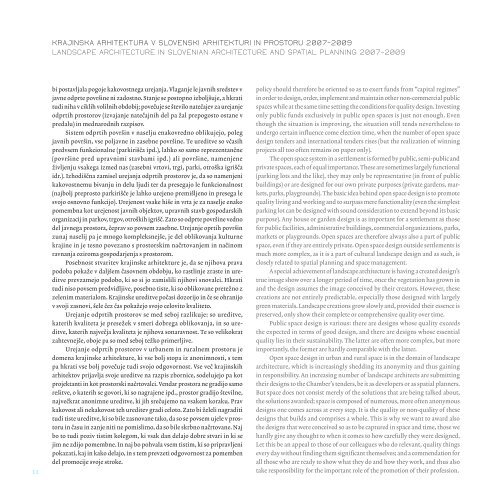
![Gradbeno izvajanje [35 Kb] - ZAPS](https://img.yumpu.com/51562115/1/184x260/gradbeno-izvajanje-35-kb-zaps.jpg?quality=85)


